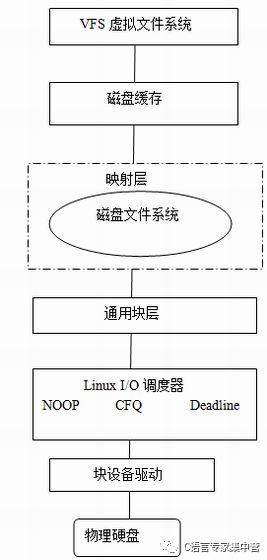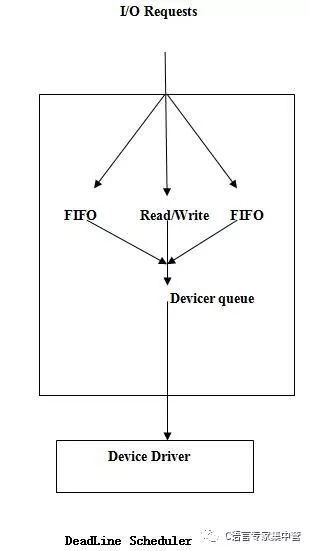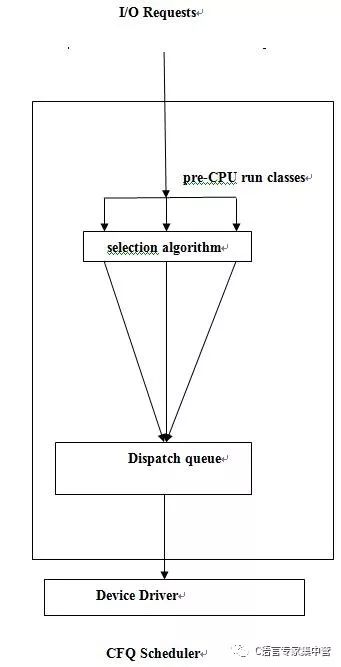Linux I/O System Introduction The Linux I/O Scheduler is a component of the Linux I/O system that sits between the generic block layer and the block device driver. As shown in Figure 1. Figure 1 Linux I/O Scheduler Between General Block and Block Device Drivers When a Linux kernel component wants to read or write some data, it does not issue a request. The kernel immediately executes the request and defers it. When transmitting a new data block, the kernel needs to check if it can pass. The Linux IO scheduler is between the generic block layer and the block device driver, so it receives requests from the common block layer, tries to merge the requests, and finds the most appropriate request to send to the block device driver. The block device driver then calls a function to respond to this request. The Linux overall I/O system can be divided into seven layers. They are: 1. VFS virtual file system: The kernel has to deal with a variety of file systems. The kernel abstracts this VFS. It is specifically designed to adapt to various file systems and provide a unified operation interface. 2. Disk caching: Disk caching is a software mechanism that retains some of the data on the disk in RAM, which makes access to this part of the data faster. There are three types of disk cache in Linux: Dentry cache, Page cache, Buffer cache. Mapping layer: The kernel reads data from the block device so that the kernel must determine the location of the data on the physical device. This is done by the mapping layer. 4. Generic block layer: Since most of the I/O operations are dealing with block devices, Linux provides a block device operation abstraction layer similar to the vfs layer. The lower layer interfaces with various block devices of different attributes and provides a unified Block IO request standard. 5. I/O scheduling layer: Most of the block devices are disk devices, so it is necessary to set some different schedulers based on the characteristics of these devices and their application characteristics. 6. Block device drivers: Block device drivers provide advanced device operation interfaces. 7. Physical hard disk: This layer is the specific physical device. Five types of Linux I/O schedulers Linux supports I/O schedulers starting from the 2.4 kernel. So far there are 5 types: Linus Elevator for Linux 2.4 kernels, Deadline, Anticipatory, CFQ, and Noop for Linux 2.6 kernels, where Anticipatory was removed from the Linux 2.6.33 release. Now. The current mainstream Linux distribution uses Deadline, CFQ, and Noop I/O schedulers. The following is a brief introduction: 1 Linus Elevator It is the first I/O scheduler in the 2.4 kernel. Its main role is to maintain a query request for each device. When the kernel receives a new request, it merges if it can merge. If it can't merge, it will try to sort. If you can neither merge nor insert a suitable location, put it at the end of the request queue. 2 Anticipatory The Chinese meaning of Anticipatory is "anticipatory, expected". As the name implies, when an I/O occurs, if another process requests an I/O operation, it will generate a default 6-millisecond guess time, guessing the next process request I /O is what to do. This I/O scheduler optimizes service time for read operations, waits for a short time while providing an I/O, and allows the process to commit to another I/O. The Anticipatory algorithm was removed from the Linux 2.6.33 release because the use of CFQ can also achieve the effect of Anticipatory. 3 DeadLine Translating Deadline into Chinese is a Deadline Scheduler, an improvement over Linus Elevator that prevents some requests from being processed for too long. In addition, you can distinguish between read operations and write operations. DEADLINE additionally provides FIFO queues for read I/O and write I/O. Deadline's workflow is shown in Figure 2. Figure 2 Deadline workflow 4 CFQ CFQ full name Completely Scheduler, Chinese name is completely fair scheduler, it is now the default scheduler for many Linux distributions, CFQ is the kernel selected by default I / O scheduler. It places the synchronization requests submitted by the process into multiple process queues, and then allocates a time slice for each queue to access the disk. For a common server is the best choice, CFQ evenly distributes access to I/O bandwidth. CFQ creates a separate queue for each process and thread to manage the requests generated by the process to ensure that each process is well allocated to the I/O bandwidth. The I/O scheduler executes one at a time. 4 requests for the process. The characteristic of this algorithm is to sort according to the address of the I/O request instead of responding in the order of arrival first. In simple terms, all synchronization processes are allocated a time slice before they are queued to access the disk. The CFQ workflow is shown in Figure 3. Figure 3 Workflow of CFQ 5 NOOP NOOP stands for No Operation. The Chinese name is an elevator scheduler. This algorithm implements the simplest FIFO queue, and all I/O requests operate in the order of arrival first. NOOP implements a simple FIFO queue that organizes I/O requests just like the elevator master method. It is the simplest I/O scheduler in the Linux kernel based on the concept of a first-in, first-out (FIFO) queue. This scheduler is best suited for SSDs. The NOOP workflow is shown in Figure 4. Figure 4 NOOP workflow I/O scheduler selection At present, the mainstream Linux distributions use three types of I/O schedulers: DeadLine, CFQ, and NOOP. Generally, Deadline is suitable for most environments, and in particular writes to many file servers. In principle, DeadLine is a Improve the mechanical hard disk throughput as a starting point to consider the scheduling algorithm, as far as possible to ensure that when the I / O request reaches the deadline for scheduling, it is very suitable for business is relatively single and I / O pressure is relatively heavy business, such as Web servers, database applications, etc. . CFQ allocates equal bandwidth for all processes. It is applicable to multi-user systems with a large number of processes. CFQ is a more general scheduling algorithm. It is a scheduling algorithm that takes the process as a starting point to ensure that everyone is as fair as possible. The process allocates the same amount of bandwidth and is suitable for desktop multitasking and multimedia applications. NOOP is the best choice for flash memory devices and embedded systems. Using NOOP is best for SSDs, followed by DeadLine, and CFQ is the least efficient.
Which is the most welcome kid laptop for entertainment and online learning? 10.1 inch laptop is the best choice. You can see netbook 10.1 inch with android os, 10.1 inch windows laptop, mini laptop 10.1 inch 2 in 1 windows, 10.1 inch 2 In 1 Laptop with android os. Of course, there are various matches of memory and storage, 2 32GB or 4 64GB. Our suggestion is that 10.1 inch android 32GB laptop, 10.1inch 32GB or 64GB Solid State Drive windows laptop. Except 10.1 inch Student Laptop , there are 11 Inch Laptop, 15.6 Inch Laptop, 14 Inch Laptop , also option here.
Besides, other advantages you can see on 10.1inch Budget Laptop For Students, for example, lightweight, competitive cost, portability, Android or Windows OS, rich slots, energy saving cpu, etc.
As a professional manufacturer, can provide free custom service, like mark client`s logo on laptop cover, opening system, inner color box, manual, boot. Produce as your special requirement on parameters, preinstall apps needed, etc. What you need to do is very simple, confirming PI, including price, delivery time, parameters, etc.
10.1 Inch Laptop,Netbook 10.1 Inch,10.1 Inch 2 In 1 Laptop,10.1 Inch Windows Laptop,Mini Laptop 10.1 Inch Henan Shuyi Electronics Co., Ltd. , https://www.shuyiminipc.com


April 14, 2023